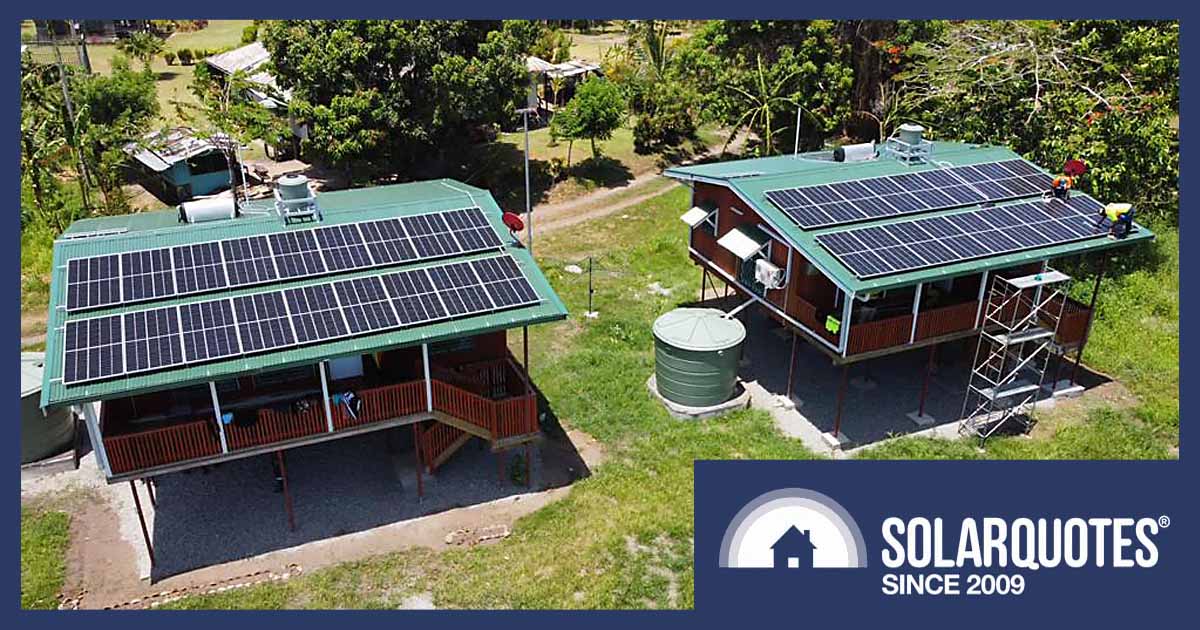
Recently things warmed up for Tasmanian solar company I Want Energy when they partnered with Astra Solar in Port Moresby, Papua New Guinea, to deliver four off-grid solar power projects in Bougainville PNG. The lucky recipient of these projects was APTC Bougainville Technical College, located in the Tinputz district on the main island.
APTC (Australian Pacific Training Coalition) is an Australian Government initiative in partnership with the Pacific and Timor-Leste. It is implemented by TAFE Queensland, and supported by DFAT (Department of Foreign Affairs and Trade1).
Rob Manson, founder, and CEO of I Want Energy spoke about their involvement with the installation.
“The college had survived on an unreliable diesel generator, which wasn’t student friendly due to noise and pollution; not to mention the high running cost. The new Sungrow off-grid systems are the first time these students have used electricity that hasn’t been produced by fossil fuels. With renewable energy the students can now study computer science and other subjects quietly and a lot more efficiently.”
Dirty Diesel
Bougainville, like many of its Pacific neighbours, is almost completely reliant on diesel generators for electricity. As far as renewables go, being a mountainous island with high rainfall and many rivers, hydro is one of the first renewable projects to be considered. Currently, there is a hydropower station being built at Ramazon in the Tinputz District, with feasibility studies being carried out on others that may be a mix of hydro and solar power.
APTC released a tender in 2021 for off-grid solar to replace the diesel generator supplying power to the college. Rob’s bid and design was awarded the contract. Two houses and two classrooms are now all running off-grid with a combined installed capacity of 36kW solar and 77kWh batteries.
One-on-one training was conducted by IWE (I Want Energy) in Port Moresby for local Astra Solar staff in May 2022, in preparation for the Bougainville job. Four Astra Solar staff installed the systems in October, and tech support was offered remotely by IWE and Scott Sui from Sungrow in Sydney.
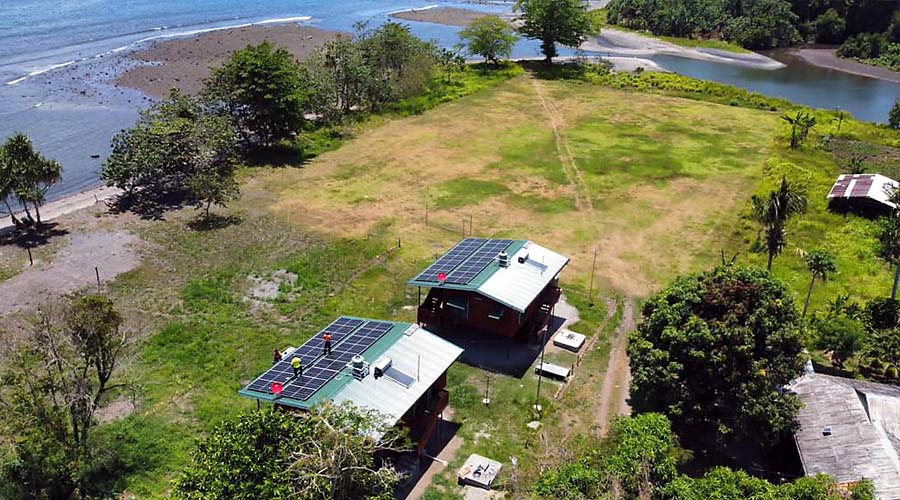
Drone shot of the solar installation. Image: I Want Energy
Off The Beaten Track
Most Australian off-grid solar companies know of the logistical difficulties faced when installing solar power in the outback. If you don’t bring everything with you, it’s a long trek back to civilization, and the budget can quickly get blown to pieces.
This job in Bougainville, however, takes remote to another level. Rob says:
“We filled a twenty-foot container with gear for the job, and shipped it from Port Moresby to Lae, and then on again to Bougainville.”
Lae is the second-largest city in PNG, and the largest cargo port. The destination and install site is located near the Tinzput harbour, but due to its small size is unsuitable for shipping a container, so it was unloaded at the main port in the capital, Buka, and the contents were transported by “road” to the job site.
Fingers crossed everything was in that container. There are no solar equipment suppliers in Bougainville, and you can’t exactly nip down to Bunnings and grab another packet of cable ties.
“Being so remote, access to hardware is difficult. A forty-minute drive on very rough roads followed by a twenty-minute boat ride gets you to a small hardware store.”
The job was well planned, and apparently, only one of those trips to the hardware store was needed.
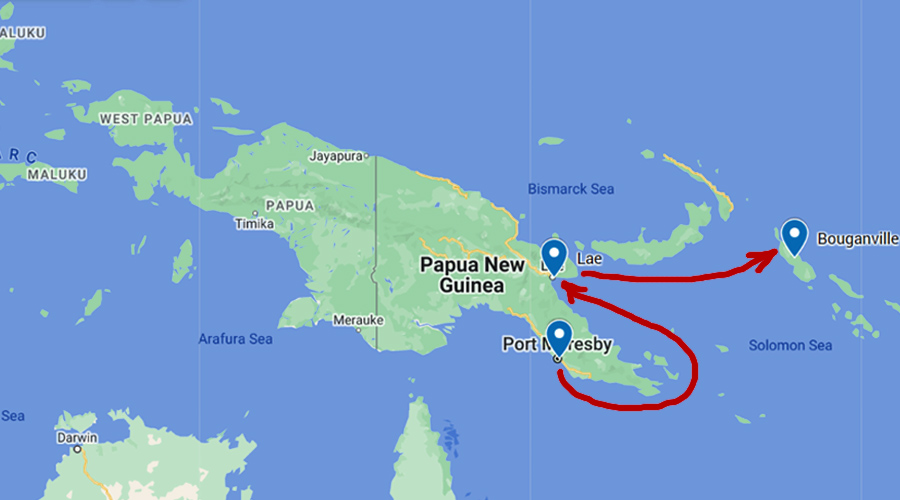
It’s a long way from Port Moresby to Bougainville by boat. Image: I Want Energy
The Solar And Battery Installation
Each of the two teachers’ houses had 9 kW (18 x Trina 500 W) of solar panels, a Sungrow SH6.0RS 6 kW hybrid inverter, and a 19.2 kWh Sungrow battery installed; and double that for the two classrooms – a total of 36 kW solar and 77 kWh of batteries.
Sungrow is the world’s second-largest inverter manufacturer, and takes its social corporate responsibility very seriously; actively participating in social welfare activities, including poverty alleviation, donations to schools, and disaster relief.
Rob says the reason he chose Sungrow to supply inverters and batteries was the company is well-established and reliable, and tech support is great. Replacements are easily available in Port Moresby.
A hybrid inverter, by definition, is a combination of a solar and a battery inverter into a single piece of equipment that can manage power from your solar panels, solar batteries, and grid at the same time. They usually operate in one of four modes – grid-tie mode, hybrid mode, backup mode, and off-grid mode.
Be warned! Hybrid inverters are generally not recommended for fully off-grid solar installations in a typical Australian household. More suitable – a dedicated off-grid battery inverter-charger is built with a heavy-duty transformer to provide high surge and peak power output and can handle high inductive loads such as water pumps, compressors, washing machines, and power tools.
Hybrid inverters are transformer-less, with switching transistors and usually have lower surge and peak power output ratings. That said, the inverters in this particular installation are supplying mostly small resistive loads such as lighting, but also computers and small ceiling fans.
I couldn’t find the surge rating of the Sungrow SH6.0RS 6 kW hybrid inverter on the datasheet, but this YouTube video is pretty impressive, showing two 2.2 kW fans operating on an SH6.0RS inverter with an SBR battery in off-grid mode. These fans have starting currents of five times the operating current, all supplied by the battery via the inverter.
The Sungrow SBR192 batteries each have a usable energy rating of 19.2 kWh, which is 100% depth of discharge (in test conditions at 25ºC). They are a stackable system of six modules, each offering 3.2 kWh of usable capacity.
The Trina 500W solar panels are high-power, large-size commercial panels, which are marginally more efficient than domestic ones. Trina is a well-respected name in solar panel manufacturing, and a Tier 1 manufacturer. The company also has a strong focus on environmental and social responsibility.
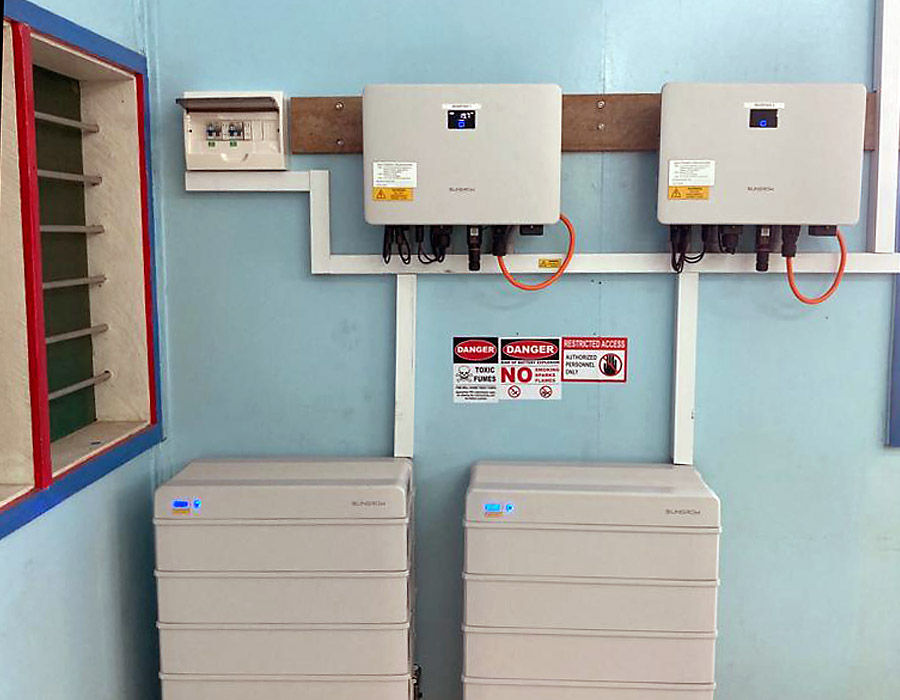
Sungrow dual inverters and batteries. Image: I Want Energy
What Now?
Whether any sort of electricity grid will ever reach this part of the world is anybody’s guess. If so, this system can be re-configured in grid-tied mode.
As far as maintaining the system goes – IWE has partnered with a local Bougainville electrician who they are mentoring to help maintain the system. He also assisted with the installation to gain some valuable solar energy experience.
Rob says the college teachers and students are thrilled with the result, and can now get on learning in relative silence. See the pic below of students checking out the hardware.
He also says that IWE plans more work in Port Moresby and Mount Hagen in PNG in the new year. I’ll keep you posted on that as it comes to light (pun intended).
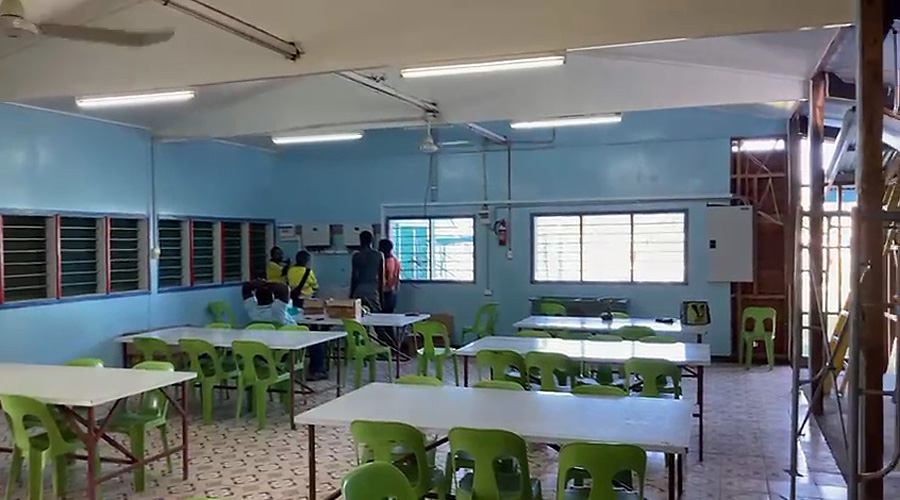
Students inspecting the installation. Image: I Want Energy
Other DFAT Funded Pacific Renewable Energy Projects
Tina River Hydropower Transmission System, Solomon Islands
The Australian Infrastructure Financing Facility for the Pacific (AIFFP) has partnered with the Solomon Island Government to fund the transmission system that will connect the Tina River Hydropower Facility to the Honiara electricity grid.
Palau Solar Project, Palau
AIFFP has provided financing to Solar Pacific Pristine Power to support the construction of Palau’s first utility-scale solar and battery energy storage facility. The project is expected to generate 20 per cent of Palau’s energy needs by replacing diesel with renewable energy.
Tonga Renewable Energy Program, Tonga
The Outer Island Renewable Energy Project (OIREP) is being co-financed by Australia, along with other donors including the European Union, to reduce Tonga’s dependence on imported fossil fuels for power generation.
Kamapim Pawa project, PNG
Funded by the PNG-Australia Partnership, a total of 350 solar street lights will be distributed throughout rural villages to increase lighting and improve access to village facilities. This will reduce dependence on burning local vegetation for lighting, increase the quality of light after dark, and improve local safety.
Footnotes
- As of 2014, DFAT has been responsible for Australia’s official foreign aid to developing countries. Formerly known as AusAID (Australian Agency for International Development) since 1995, it was merged into DFAT without prior consultation by the Abbott Government in 2014, with aid slashed to most regions apart from the Pacific region. Australian Aid is now the brand name used to identify projects in developing countries supported by the Australian Government. ↩

 RSS - Posts
RSS - Posts



Very impressive. I am interested because I am planning to use solar to power up deep freezers for storing freezer goods.